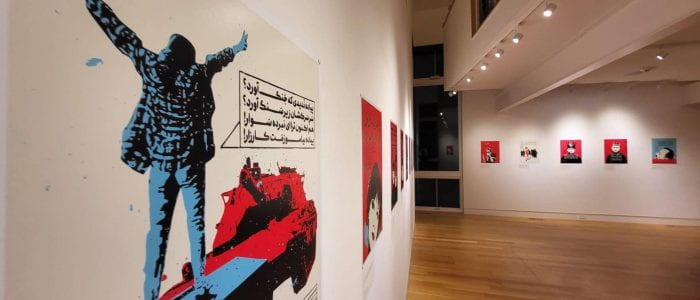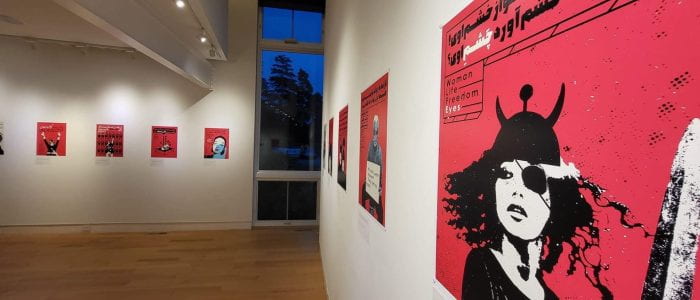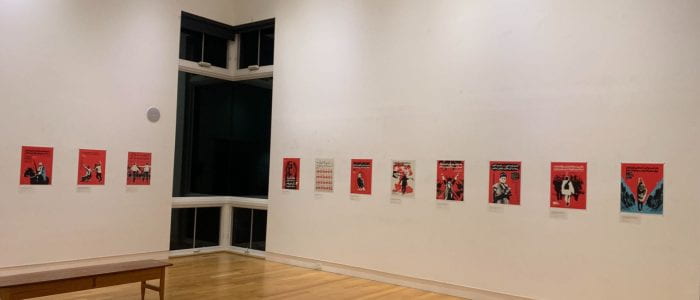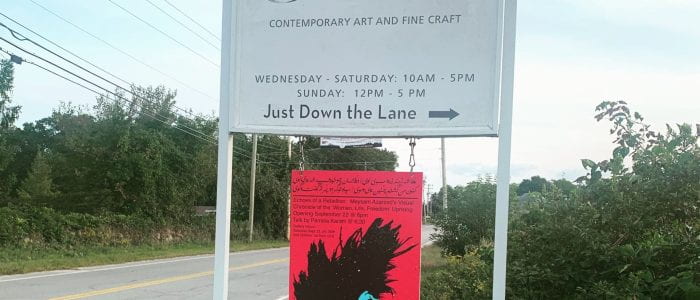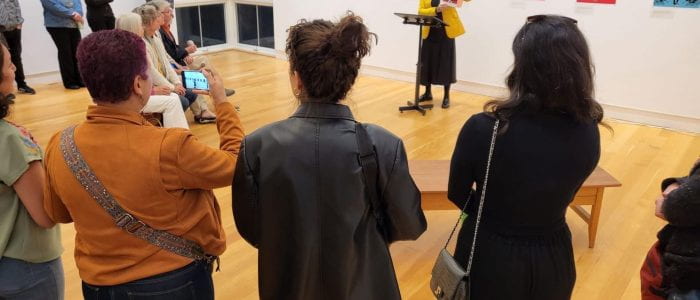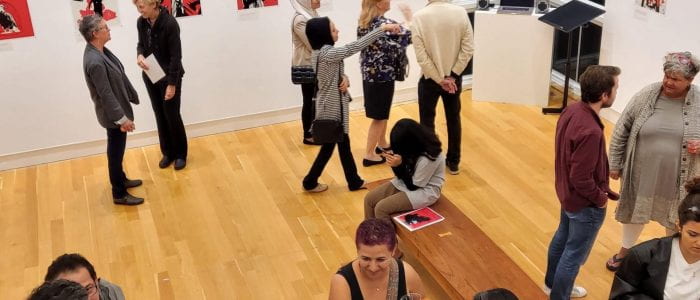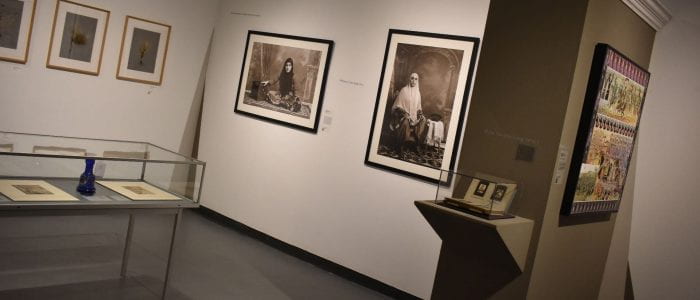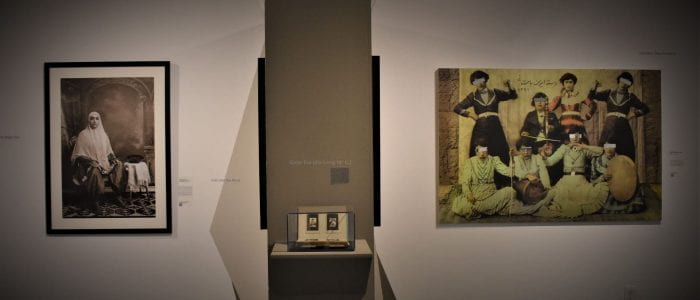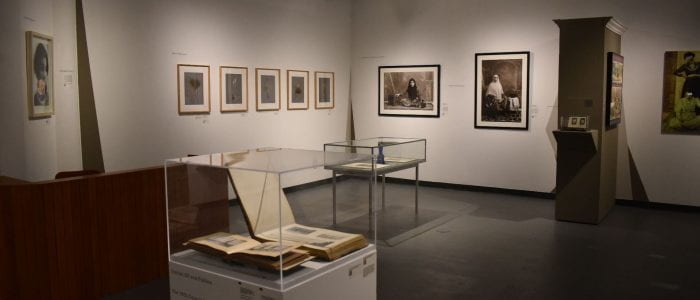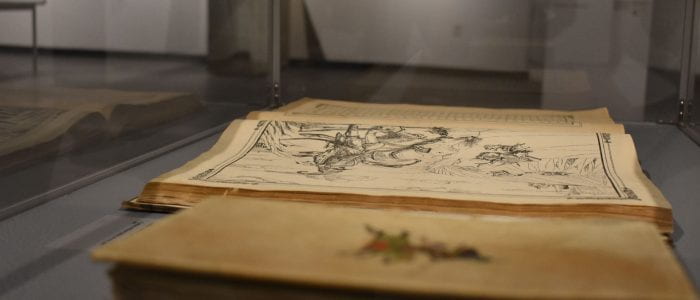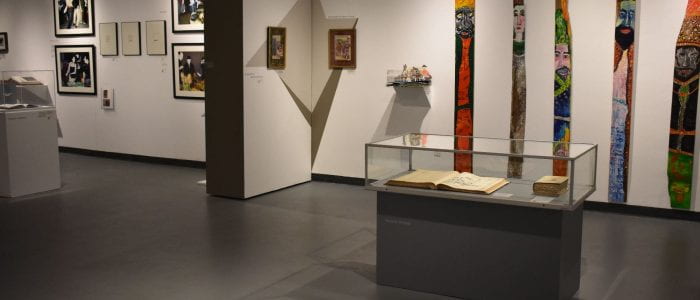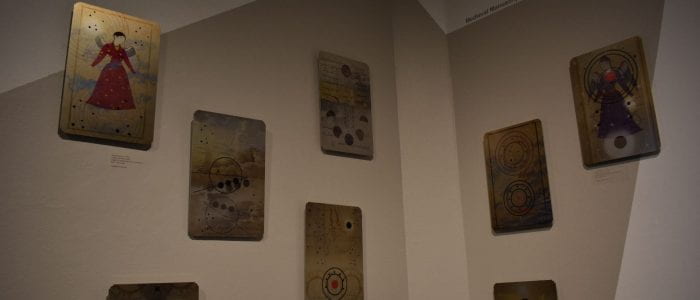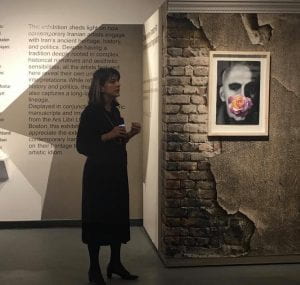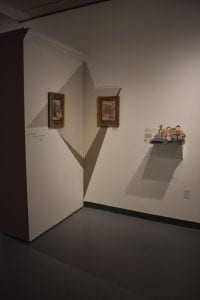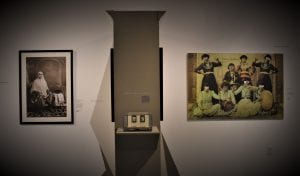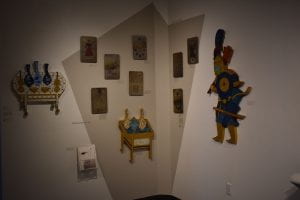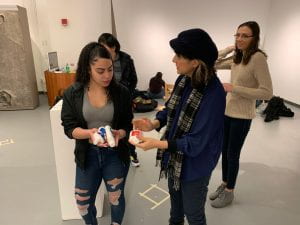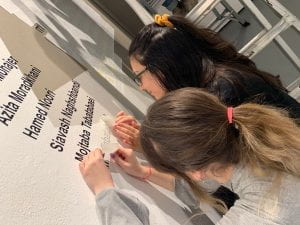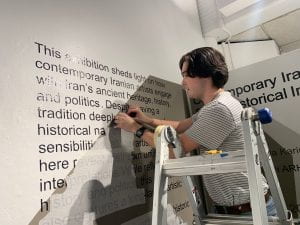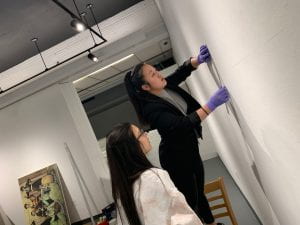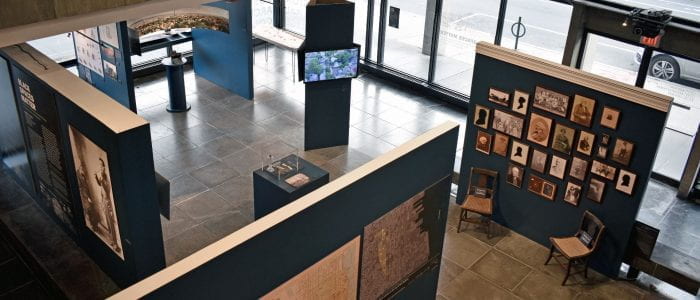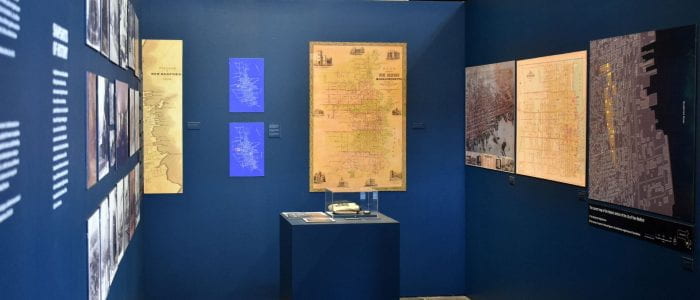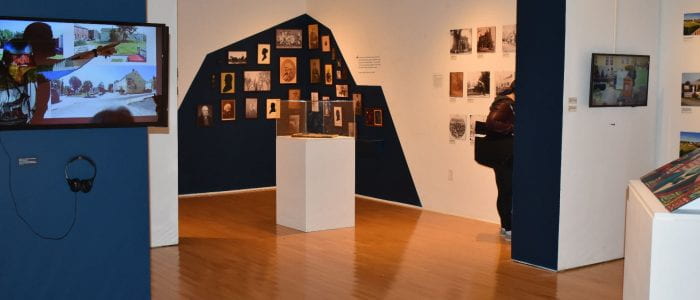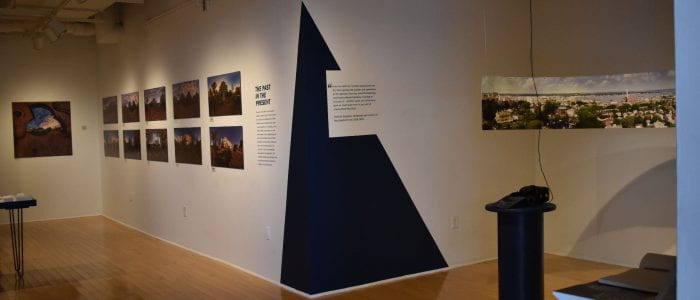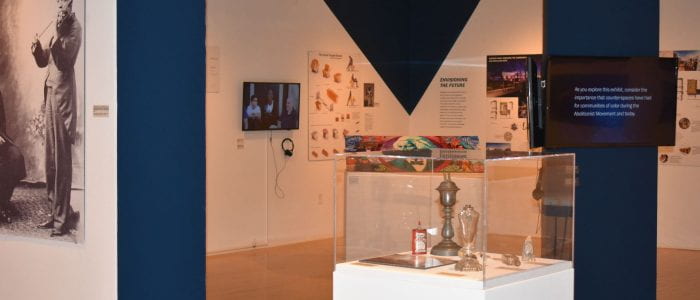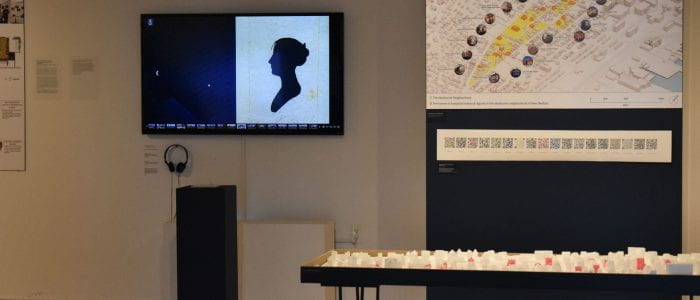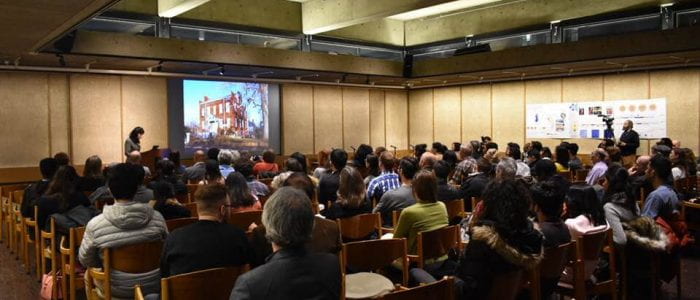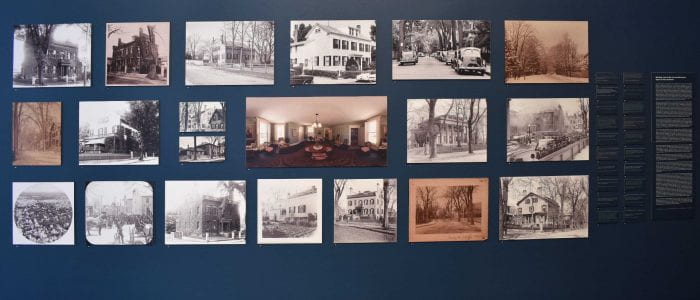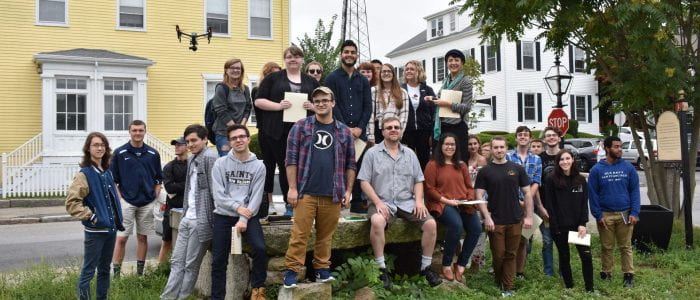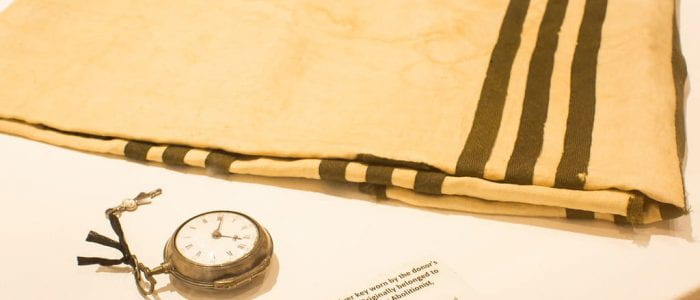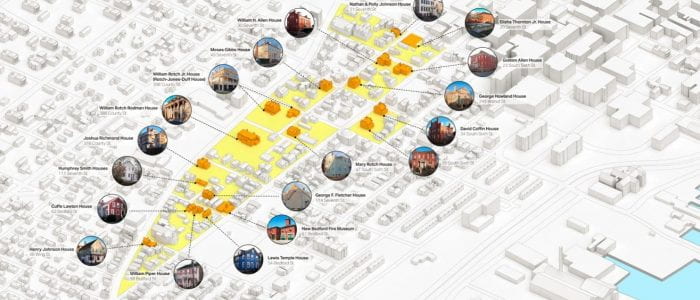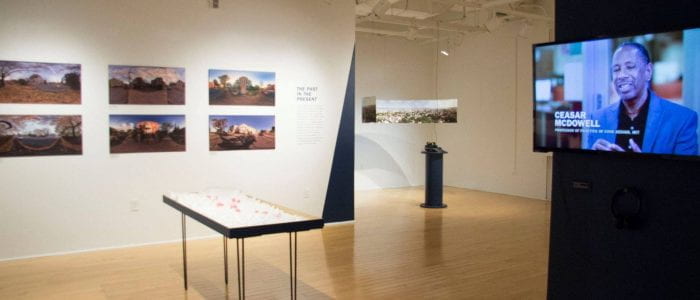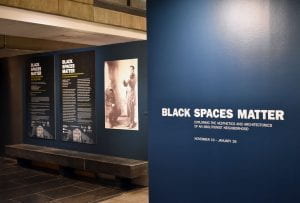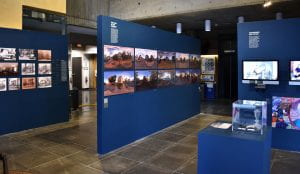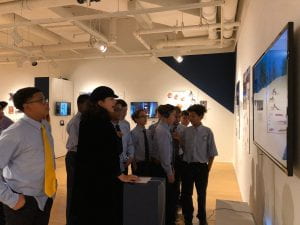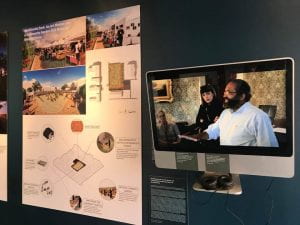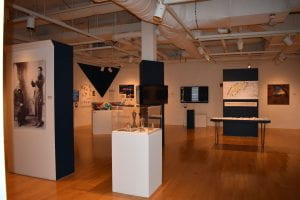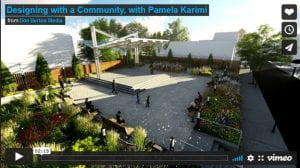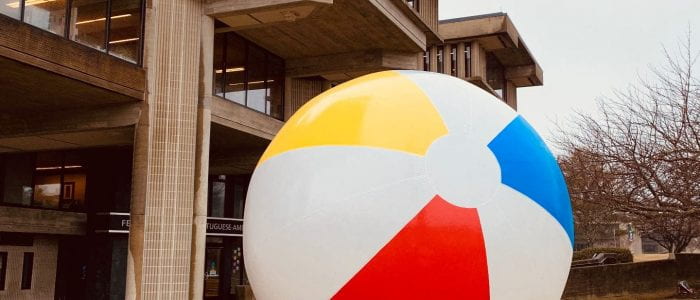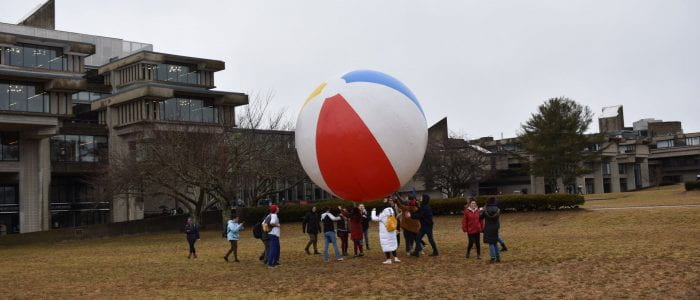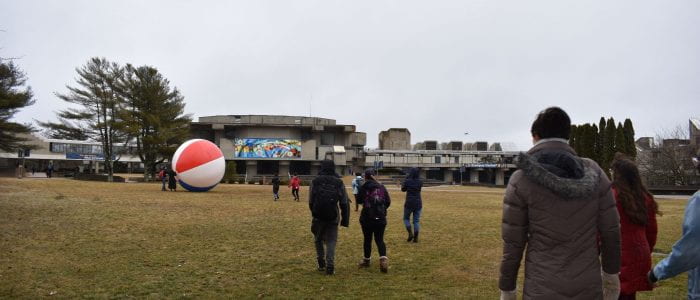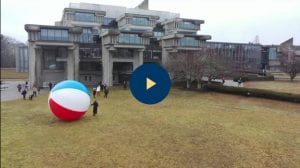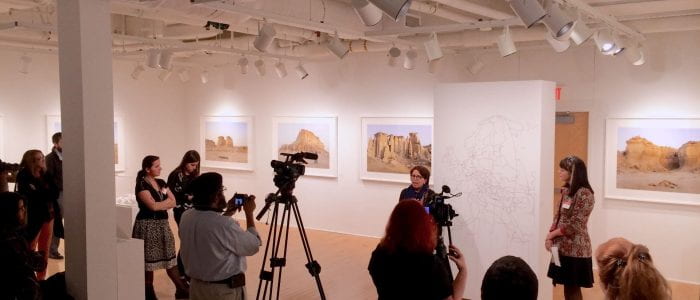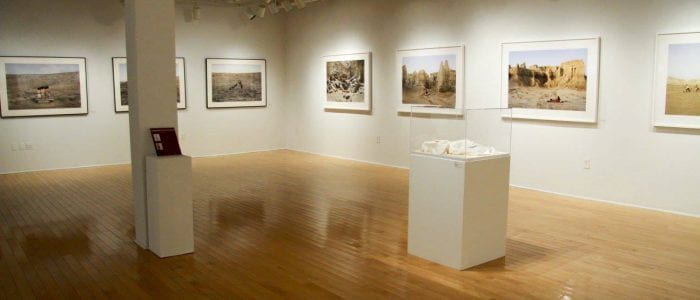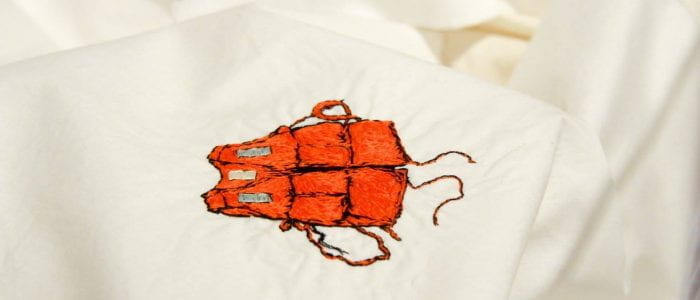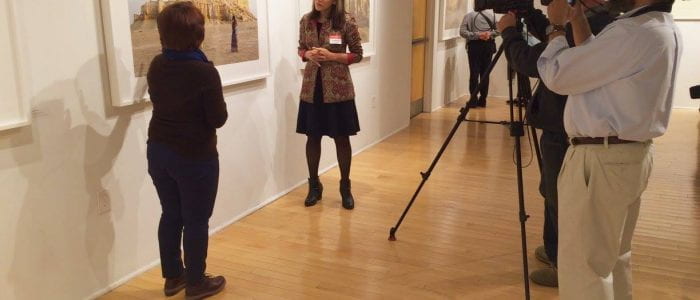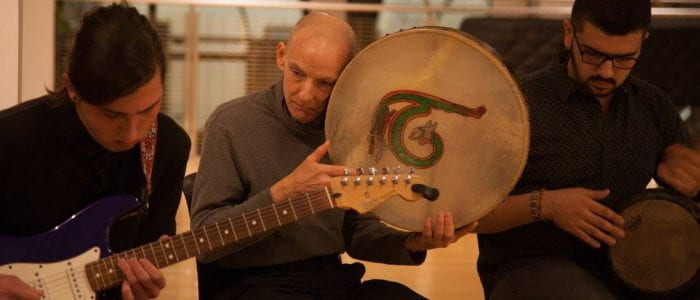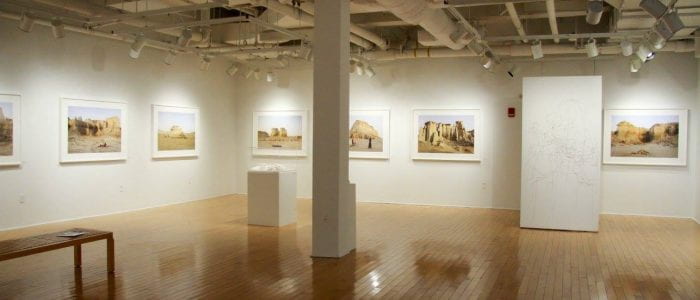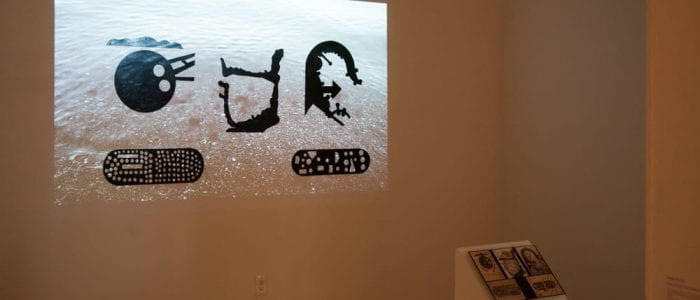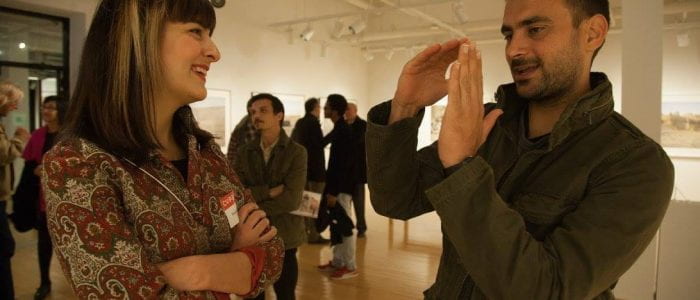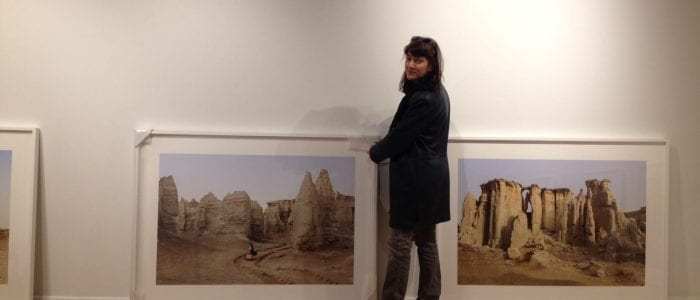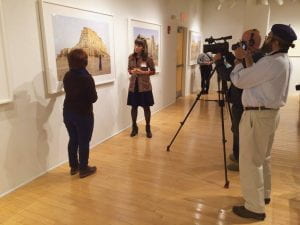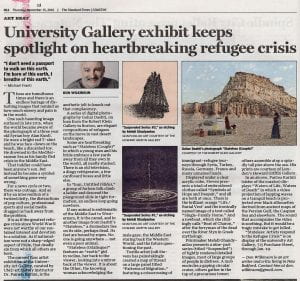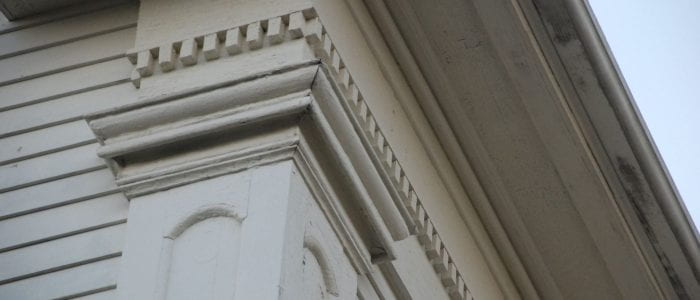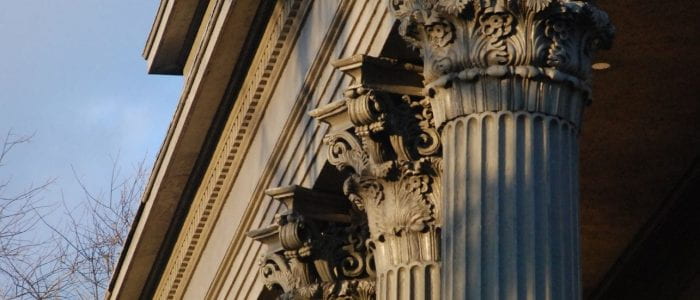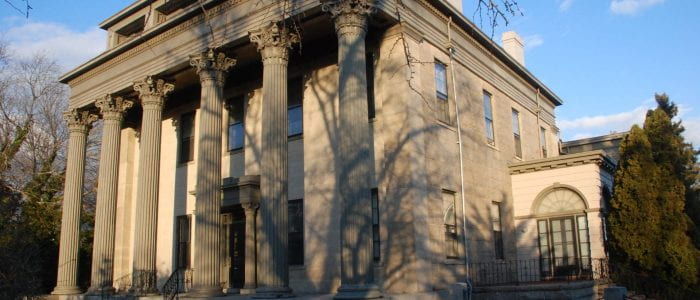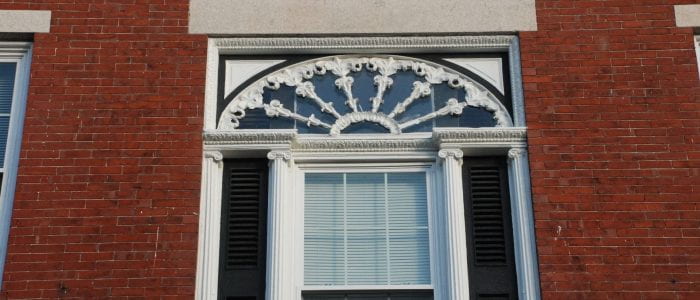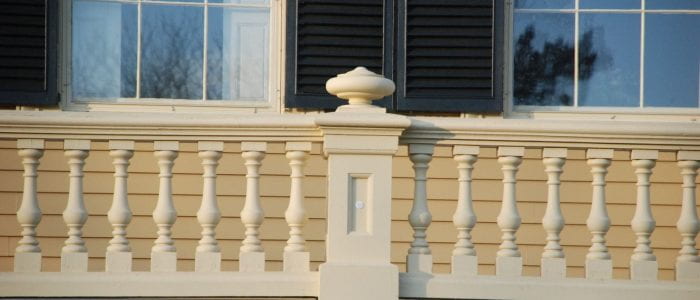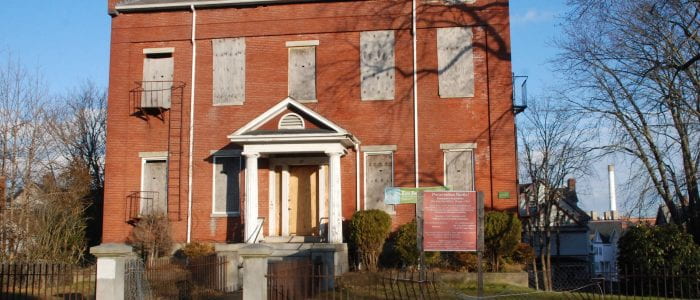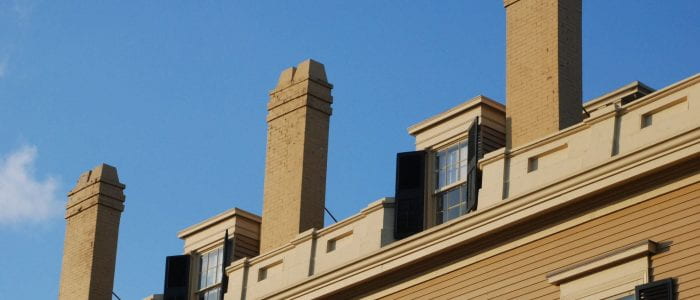Curatorial Projects
Echoes of a Rebellion: Meysam Azarzad’s Visual Chronicle of the ‘Woman, Life, Freedom’ Uprising
To commemorate the one-year anniversary of Iran’s “Woman, Life, Freedom” uprising, the Dedee Shattuck Gallery in Westport, MA proudly presents a solo exhibition featuring the works of Tehran-based activist artist Meysam Azarzad. We invite you to join us for the exhibition’s opening on September 22nd at 6pm. At 6:30pm, the exhibition’s curator, Professor Pamela Karimi, will discuss Meysam’s art and provide insights into the “Woman-Life-Freedom” uprising in Iran.
Contemporary Iranian Art & the Historical Imagination
February 20 – April 1, 2020 at the CVPA Gallery
Lead curator
For more information and a full list of contributors to this project go to this link.
Karimi offers her remarks at the opening of the exhibition.
This exhibition was organized in conjunction with Professor Pamela Karimi’s class, Art & Politics in the Middle East. The course examines the politics involved in (re)presenting, marketing, exhibiting and discussing contemporary Middle Eastern art. Students had the opportunity to examine the thematic frameworks that currently situate Middle Eastern art within the global discourse of art. In addition to readings and discussions, students were required to contribute to organizing an exhibition about contemporary Iranian art. The Exhibition featured high-quality artworks from the collections of Azita Bina, Elmar Seibel, Ars Libri Ltd., Gallery Kayafas as well as personal collections of several Iranian and Iranian-American artists. The exhibition shed light on how contemporary Iranian artists engage with Iran’s ancient heritage, history, and politics. Despite having a tradition deeply rooted in complex historical narratives and aesthetic sensibilities, all the artists featured here revealed their own unique interpretations.
While reflecting on history and politics, this exhibition also captured a long-lasting artistic lineage. Displayed in conjunction with historic manuscripts and images on loan from the private collection of Elmar Seibel and Ars Libri Ltd in Boston, this exhibition invited audiences to appreciate the extent to which contemporary Iranian artists build on their heritage to craft a unique artistic idiom. Through this exhibition, participating students had the opportunity to hone their skills in all aspects of curation and exhibition design: from handling precious artwork to installing vinyl lettering and from label writing to selecting color themes for the gallery walls. Additionally, they were required to deliver short presentations on the thematic sections of this exhibition, including the Shahnameh [the Book of Kings], medieval manuscripts, Qajar Iran, the 1953 Coup, the 1979 revolution, censorship and many more. For more information and a full list of collaborators’ names go to this link.
Karimi’s students in her upper-division course, Art & Politics in the Middle East, participated in installing the exhibition.
Black Spaces Matter: Celebrating New Bedford’s Abolition Row
Exhibition Dates: November 8, 2018 – January 30, 2019 at the University Art Gallery and November 19, 2017-January 29, 2018 at the McCormick Gallery at the Boston Architectural College
Lead curator
For more information and a full list of collaborators go to this link.
Gallery views and audience engagement at Black Spaces Matter.
This exhibition showcased the abolitionist neighborhood near the New Bedford Whaling National Historical Park. This neighborhood, which was the home of many African Americans, white and black abolitionists, and former slaves, provides a lens with which one may study interracial aspects of American cities.
New Bedford’s architecture reflects a period of relative racial equality and tolerance in “the City that lit the world” during its whaling boom. This neighborhood includes a mixture of Gothic Revival, Federal, Greek Revival, and early Italian homes, as well as modest cottages. Important historical figures, such as Fredrick Douglass and Lewis Temple, resided in these homes.
In recent years, we have seen a growing body of literature on race and architecture. However, this scholarship has focused mostly on the negative side of such built environments, lacking an in-depth exploration of the form and function of interracial neighborhoods. This exhibition celebrated the aesthetics and architectonics of New Bedford’s Abolition Row where many former slaves lived side-by-side with the rest of the population and engaged multiple aspects of the City’s interracial architecture.
Through this exhibition, local New Bedford experts along with Karimi’s students and other faculty from UMass Dartmouth revealed a lesser-known progressive interracial neighborhood in the United States. For more information and a full list of collaborators’ names this link.
***This exhibition was Reviewed in the Standard Times; listed as top things to do in Boston by WBUR; Reviewed in the Bay State Banner; Reviewed in Architecture Boston Magazine; Reviewed in the Heights (Boston College’s official Student News Paper); Reviewed in Architectural Research Quarterly Journal.
Video featuring the involvement of Karimi’s students in Black Spaces Matter Exhibition. Courtesy of Don Burton. Click here or on the image itself to see the video.
Participatory Art at UMassD Quad
An Afternoon of Art Performance and Lectures by Social Practice Artist Negar Farajiani
February 2019 at UMass Dartmouth campus quad
Lead curator
For more information and a full list of contributors to this project go to this link.
This event was organized by professor Pamela Karimi of the Art Education, Art History and Media Studies Department at the College of Visual and Performing Arts. The event featured the work of Tehran-based artist, Negar Farajiani.Titled “Made in China,” Farajiani’s UMD quad interactive art project was previously presented in conjunction with major events and festivals and in several cities around the world, including in Tehran, Seattle, Tbilisi, Dubai, Toronto and Chicago. For more information and a full list of contributors to this project click on the image below or go to this link.
Video of the participatory art project. Courtesy of Karimi’s students. For more information see closing credits.
Stateless: Artists Respond to the Refugee Crisis
November 10, 2016 – January 29, 2017 at the University Art Gallery
Lead curator
For more information and a full list of contributors go to this link.
Left: Karimi speaks with artist, Gohar Dashti, at the opening of the exhibition; right: Coverage of the exhibition in the Standard Times.
Exhibition Stateless brought together the work of four artists who reflected on the European refugee crisis and issues of human displacement and migration.
The Syrian conflict and the subsequent European refugee crisis dominated not only the news headlines, but also discussions among artists and intellectuals around the world. Due to the significance of these recent events, the College of Visual and Performing Arts has dedicated an exhibition to the topic of migration. Stateless brought together the works of four artists who respond to the crisis in the Middle East.
Through a series of astonishing staged photographs in the remote deserts of the Middle East, Tehran-based photographer Gohar Dashti envisioned the plight of homelessness for the millions of people who have recently fled such war zones. Known for his ironic and surreal trompe l’oeil murals in Tehran, through a series of intricate prints artist MehdiGhadyanloo displayed the difficulties of displacement by portraying crowds of people trapped in uncertain situations. Meanwhile, California-based artist Pantea Karimi showcased a multi-media installation of abstracted medieval maps of major Middle Eastern ports, alluding to a glorious bygone era during which migration of people from and to the Middle East contributed to the advancement of knowledge and commerce. Lastly, through a series of threads interrupted by objects and images, which captured the precarious lives of stateless people, the Southcoast-based Site-specific installation artist Jodi Stevens followed the grim patterns of migration from the Middle East to Europe.
In its entirety, the exhibition inspired the viewer to reflect on the struggles endured in the displacement of migrants. For more information and a full list of contributors go to this link.
Exploring Urban Identities in De-Industrialized Cities
January 10, 2013 – February 9, 2013 at the New Bedford Art Museum
Co-curator
For more information and a full list of collaborators go to this link.
View of the exhibition at the New Bedford Art Museum.
As a once thriving industrial center which has struggled to regain its position in the 21st century economy, New Bedford, Massachusetts is exemplary of what the independent think tank MassINC has termed a “Gateway City.” Offering inexpensive commercial real estate, an eager workforce and an existing infrastructure, the gateway cities of Massachusetts1 maintain a unique potential for growth. As researchers such as Richard Florida, author of The Rise of the Creative Class (2002), have pointed out, a primary conduit for realizing this potential is the creative class. In this regard, New Bedford is ideally positioned. In a recent study by the U.S. Census Bureau, the area was ranked the seventh “Most Artistic City in the Nation” due to its high concentration of artists, galleries and museums. The project leveraged these assets to illuminate the role of the creative sector in both the past glory and the future economic revitalization of Massachusetts gateway cities such as New Bedford.
Through a three-pronged approach which integrated lectures, a public art exhibition and a summary publication, the project engaged multiple sectors of the city’s cultural life. The lecture series brought together local historians, prominent national and international scholars, and area artists in order to chronicle the cultural and economic history of New Bedford and other gateways cities in Massachusetts. While these cities are known for pre-Depression architecture in the country, the past decades have seen many of these treasures sit vacant, waiting for economic revival. The lectures shed light on the past, present, and future situations of some of these landmarks, educating the community about the importance of the history and continued survival of these buildings. Some of these lectures focused on architecture and the built environment; others explored the impact the creative sector has had on this prosperity. The lectures were presented on the popular “AHA! Night” in New Bedford, a free cultural evening which is held in the city’s historic downtown each month. The lecture series was accompanied by an art exhibition showcasing the work of local artists. For more information and a full list of contributors to this project, go to this link.

